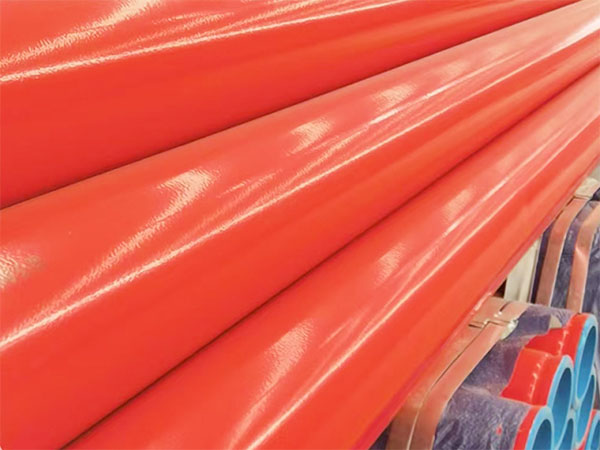Due to the limited anti-corrosion ability of
carbon steel pipes, they are prone to corrosion and rusting when working in highly corrosive environments. Therefore, it is often necessary to apply a coating on the surface or inside of carbon steel pipes. Such pipes are called coated carbon steel pipes.
Coated carbon steel pipes enhance the corrosion resistance and service life of carbon steel pipes by applying a composite coating on the outer wall, inner wall or both of the pipes. Each type of coating typically provides specialized protection for different application environments (underground, Marine, water treatment, industrial pipelines, etc.). Common products include FBE-coated pipes, 3PE-coated pipes, hot-dip galvanized pipes, asphalt-coated pipes, concrete-coated pipes, etc.

Common coatings:
FBE (Fusion Bonded Epoxy) coating: A 400-600 μm hot melt epoxy film formed by electrostatic dry powder spraying on the pre-treated (sandblasting, preheating) surface of pipes, chemically resistant and corrosion-resistant, suitable for underground and underwater pipelines.
3PE/3PP polymer coating: Generally, it is a three-layer structure: the first layer is FBE powder epoxy as the bonding layer, the middle layer is epoxy or adhesive, and the outer layer is high-density polyethylene (3PE) or polypropylene (3PP), which enhances mechanical protection and waterproof performance and is often used in buried oil and gas pipelines.
Hot-Dip Galvanizing: A dense zinc layer is formed on the surface of the steel pipe, providing a physical barrier and sacrificial anode protection, and is suitable for outdoor and Marine environments.
Bitumen/Asphalt coating: The most common buried anti-corrosion method in the early days, with low cost, simple construction, and good adaptability to moist soil environments.
Concrete/Cement Mortar coating: It is usually used for submarine or hydraulic structure pipelines, playing a role in anti-corrosion, anti-pressure and mechanical protection; Cement mortar lining can also be done inside the pipe to prevent fluid corrosion.
Multi-layer epoxy + polymer: such as FBE+3PE, epoxy + Polyurethane (Polyurethane), etc., superimpose different coating properties to meet complex working conditions.
Asphalt + concrete: First, apply asphalt for rust prevention, then wrap it with a concrete layer. It is commonly used in underwater and heavy-duty pipelines.
Common coated carbon steel pipes
FBE anti-corrosion carbon steel pipe
Single-layer epoxy powder bonding, with a thickness generally ranging from 150 to 300 μm, is easy to apply and suitable for temperatures up to 150 °C.
3PE (FBE+ primer +PE) carbon steel pipe
Epoxy powder primer + carbon black isolation layer + thermoplastic polyethylene, with a total coating thickness of 0.7-1.2mm, and excellent comprehensive mechanical properties.
3PP (FBE+ primer +PP) carbon steel pipe
Similar to 3PE, but with a polypropylene surface layer, it can be used in working conditions above 100 °C and is resistant to hydrogen sulfide and oil erosion.
Epoxy coal tar asphalt coated pipe
The coating thickness is 300-600 μm. It is economical, resistant to soil corrosion, and is mostly applied by brushing or spraying.
Cement mortar lined pipe
The inner lining thickness is 2 to 3 mm, providing a smooth water supply channel surface and being resistant to erosion. It is mainly used for tap water and sewage.
Concrete-coated pipe
The outer wall is wrapped with a 30-80mm concrete layer, which is used for direct seabed burial or long-distance underground pipelines, providing counterweight and secondary anti-corrosion.
Hot-dip galvanized pipe
The surface zinc coating thickness is 65-115 g/m², which is resistant to atmospheric corrosion and is commonly used in outdoor gas, fire protection and decoration.
Different coating materials and processes each have their own advantages and disadvantages, and a comprehensive consideration is needed when making a choice:
Medium properties (whether it contains hydrogen sulfide, oxidants, acids, bases, etc.)
Operating temperature (High-temperature resistant coating should be selected for high-temperature environments)
Mechanical damage risk (for underground and underwater applications, stronger thermoplastic coatings or concrete cladding are required)
Economic cost (The cost of coal tar asphalt coating is low, but the long-term maintenance cost is high; 3PE/3PP requires a large initial investment but has a long life cycle.
